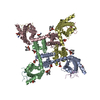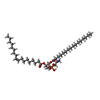+Search query
-Structure paper
| Title | Structural Basis of Nav1.7 Inhibition by a Gating-Modifier Spider Toxin. |
|---|---|
| Journal, issue, pages | Cell, Vol. 176, Issue 4, Page 702-715.e14, Year 2019 |
| Publish date | Feb 7, 2019 |
 Authors Authors | Hui Xu / Tianbo Li / Alexis Rohou / Christopher P Arthur / Foteini Tzakoniati / Evera Wong / Alberto Estevez / Christine Kugel / Yvonne Franke / Jun Chen / Claudio Ciferri / David H Hackos / Christopher M Koth / Jian Payandeh /  |
| PubMed Abstract | Voltage-gated sodium (Nav) channels are targets of disease mutations, toxins, and therapeutic drugs. Despite recent advances, the structural basis of voltage sensing, electromechanical coupling, and ...Voltage-gated sodium (Nav) channels are targets of disease mutations, toxins, and therapeutic drugs. Despite recent advances, the structural basis of voltage sensing, electromechanical coupling, and toxin modulation remains ill-defined. Protoxin-II (ProTx2) from the Peruvian green velvet tarantula is an inhibitor cystine-knot peptide and selective antagonist of the human Nav1.7 channel. Here, we visualize ProTx2 in complex with voltage-sensor domain II (VSD2) from Nav1.7 using X-ray crystallography and cryoelectron microscopy. Membrane partitioning orients ProTx2 for unfettered access to VSD2, where ProTx2 interrogates distinct features of the Nav1.7 receptor site. ProTx2 positions two basic residues into the extracellular vestibule to antagonize S4 gating-charge movement through an electrostatic mechanism. ProTx2 has trapped activated and deactivated states of VSD2, revealing a remarkable ∼10 Å translation of the S4 helix, providing a structural framework for activation gating in voltage-gated ion channels. Finally, our results deliver key templates to design selective Nav channel antagonists. |
 External links External links |  Cell / Cell /  PubMed:30661758 PubMed:30661758 |
| Methods | EM (single particle) / X-ray diffraction |
| Resolution | 3.541 - 4.2 Å |
| Structure data | EMDB-0341, PDB-6n4q: EMDB-0342, PDB-6n4r:  PDB-6n4i: |
| Chemicals |  ChemComp-6OU: |
| Source |
|
 Keywords Keywords | METAL TRANSPORT / sodium channel / toxin / gating-modifier / voltage-gated / MEMBRANE PROTEIN / voltage-gated sodium channel / gating modifier toxin |
 Movie
Movie Controller
Controller Structure viewers
Structure viewers About Yorodumi Papers
About Yorodumi Papers







 homo sapiens (human)
homo sapiens (human) arcobacter butzleri (strain rm4018) (bacteria)
arcobacter butzleri (strain rm4018) (bacteria) thrixopelma pruriens (green velvet)
thrixopelma pruriens (green velvet)
